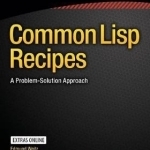Common Lisp Recipes: A Problem-Solution Approach: 2016
BookThis item doesn’t have any media yet
2016 | Computing & IT
Find solutions to problems and answers to questions you are likely to encounter when writing real-world applications in Common Lisp. This book covers areas as diverse as web programming, databases, graphical user interfaces, integration with other programming languages, multi-threading, and mobile devices as well as debugging techniques and optimization, to name just a few. Written by an author who has used Common Lisp in many successful commercial projects over more than a decade, Common Lisp Recipes is also the first Common Lisp book to tackle such advanced topics as environment access, logical pathnames, Gray streams, delivery of executables, pretty printing, setf expansions, or changing the syntax of Common Lisp. The book is organized around specific problems or questions each followed by ready-to-use example solutions and clear explanations of the concepts involved, plus pointers to alternatives and more information. Each recipe can be read independently of the others and thus the book will earn a special place on your bookshelf as a reference work you always want to have within reach.
Common Lisp Recipes is aimed at programmers who are already familiar with Common Lisp to a certain extent but do not yet have the experience you typically only get from years of hacking in a specific computer language. It is written in a style that mixes hands-on no-frills pragmatism with precise information and prudent mentorship. If you feel attracted to Common Lisp's mix of breathtaking features and down-to-earth utilitarianism, you'll also like this book.
Related Items:
| Published by | Springer-Verlag Berlin and Heidelberg GmbH & Co. KG |
| Edition | Unknown |
| ISBN | 9781484211779 |
| Language | N/A |
Images And Data Courtesy Of: Springer-Verlag Berlin and Heidelberg GmbH & Co. KG.
This content (including text, images, videos and other media) is published and used in accordance
with Fair Use.
